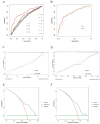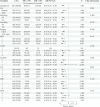Assessing the predictive value of time-in-range level for the risk of postoperative infection in patients with type 2 diabetes: a cohort study
- PMID: 40303640
- PMCID: PMC12037399
- DOI: 10.3389/fendo.2025.1539039
Assessing the predictive value of time-in-range level for the risk of postoperative infection in patients with type 2 diabetes: a cohort study
Abstract
Aim: To analyze the correlation between preoperative time-in-range (TIR) levels and postoperative infection in patients with type 2 diabetes mellitus (T2DM) and to evaluate the value of the TIR as a predictor of postoperative infection in patients with T2DM.
Methods: A total of 656 patients with T2DM during the perioperative period were divided into a TIR standard group (TIR≥70%) and a TIR nonstandard group (TIR<70%) according to the TIR value. Modified Poisson regression was used to analyze postoperative risk factors in patients with T2DM. All patients were subsequently divided into a training set and a validation set at a ratio of 7:3. LASSO regression and the Boruta algorithm were used to screen out the predictive factors related to postoperative infection in T2DM patients in the training set. The discrimination and calibration of the model were evaluated by the area under the receiver operating characteristic curve (ROC) and calibration curve, and the clinical net benefit of the model was evaluated and verified through the decision analysis (DCA) curve. Finally, a forest plot was used for relevant subgroup analysis.
Results: Modified Poisson regression analysis revealed that the TIR was a risk factor for postoperative infection in T2DM patients, and when the TIR was <70%, the risk of postoperative infection increased by 52.2% (P <0.05). LASSO regression and Boruta algorithm screening variables revealed that the TIR, lymphocytes, neutrophils, total serum cholesterol, superoxide dismutase and type of incision were predictive factors for postoperative infection in patients with T2DM (P<0.05). The calibration curve confirmed that the model predictions were consistent with reality, and the decision curve confirmed that the model had better clinical benefits. Finally, the results of the subgroup analysis revealed that in each subgroup, the risk of postoperative infection was greater when the TIR was <70% than when the TIR was ≥70%, and there was no interaction between subgroups.
Conclusion: The TIR is related to postoperative infection and can be used as a new indicator to predict the risk of postoperative infection in patients with type 2 diabetes mellitus.
Keywords: clinical prediction model; postoperative infection; risk factors; time in range; type 2 diabetes.
Copyright © 2025 Wu, Xv, Chen, Zhang, Li, Shao, Jin and Hu.
Conflict of interest statement
The authors declare that the research was conducted in the absence of any commercial or financial relationships that could be construed as a potential conflict of interest.
Figures





Similar articles
-
Nomogram Prediction for the Risk of Diabetic Foot in Patients With Type 2 Diabetes Mellitus.Front Endocrinol (Lausanne). 2022 Jul 13;13:890057. doi: 10.3389/fendo.2022.890057. eCollection 2022. Front Endocrinol (Lausanne). 2022. PMID: 35909507 Free PMC article.
-
A potent risk model for predicting new-onset acute coronary syndrome in patients with type 2 diabetes mellitus in Northwest China.Acta Diabetol. 2020 Jun;57(6):705-713. doi: 10.1007/s00592-020-01484-x. Epub 2020 Feb 1. Acta Diabetol. 2020. PMID: 32008161 Free PMC article.
-
Relationship between glycemic variability and cognitive function in lacune patients with type 2 diabetes.World J Clin Cases. 2023 Feb 16;11(5):1019-1030. doi: 10.12998/wjcc.v11.i5.1019. World J Clin Cases. 2023. PMID: 36874411 Free PMC article.
-
Development and validation of a predictive risk model based on retinal geometry for an early assessment of diabetic retinopathy.Front Endocrinol (Lausanne). 2022 Nov 21;13:1033611. doi: 10.3389/fendo.2022.1033611. eCollection 2022. Front Endocrinol (Lausanne). 2022. PMID: 36479215 Free PMC article. Clinical Trial.
-
The risk factors and predictive nomogram of human albumin infusion during the perioperative period of posterior lumbar interbody fusion: a study based on 2015-2020 data from a local hospital.J Orthop Surg Res. 2021 Oct 30;16(1):654. doi: 10.1186/s13018-021-02808-5. J Orthop Surg Res. 2021. PMID: 34717707 Free PMC article.
References
MeSH terms
LinkOut - more resources
Full Text Sources
Medical

